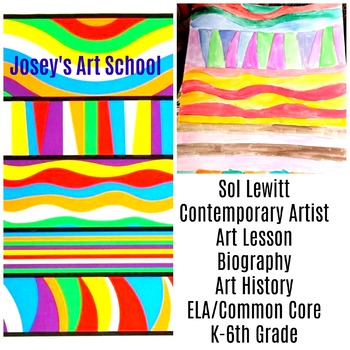Sol LeWitt Art Lesson Colors Lines Grade K 6th Grade Art History Drawing ELA
- PDF
Description
I am excited to present our art lesson featuring the legendary artist Sol LeWitt, along with a captivating art project inspired by his unique artistic style.
Sol LeWitt was a visionary artist known for his abstract and conceptual artwork. His pieces challenged traditional notions of art by emphasizing ideas and concepts over traditional craftsmanship.
My lesson plan will not only expose your students to LeWitt's groundbreaking work but also inspire them to think creatively and explore the limitless possibilities of artistic expression.
Here are three fantastic ways to incorporate this art lesson (Included in this lesson) into your elementary classroom:
- Introduction to Sol LeWitt: Start the journey by introducing your students to the fascinating world of Sol LeWitt. Share captivating stories about his life and artistic career, highlighting his innovative approach to art. Use visual aids, videos, and interactive discussions to engage their curiosity and spark their interest in his unique style.
- Exploring LeWitt's Artistic Concepts: Dive into the captivating realm of LeWitt's artistic concepts. Explore his use of geometric shapes, repetition, and modular structures. Encourage your students to analyze and discuss his artworks, fostering critical thinking and visual analysis skills. Provide them with the tools to understand how LeWitt's ideas and instructions were just as important as the final artwork itself.
- Art Project: Inspired by Sol LeWitt's style, guide your students through an exciting hands-on art project. Encourage them to create their own artwork by following a set of instructions or rules, just as LeWitt did.
Incorporating this art lesson into your classroom offers numerous benefits:
- Foster Creativity: LeWitt's emphasis on concepts and ideas encourages students to think creatively and explore unconventional approaches to art. It provides them with the freedom to express their unique perspectives and allows for a broad range of artistic interpretations.
- Critical Thinking Skills: Analyzing and discussing LeWitt's artworks and concepts will nurture critical thinking skills. Students will learn to interpret visual cues, analyze patterns, and make connections between the artist's ideas and their own artwork.
- Collaboration and Problem-Solving: Encourage collaborative projects inspired by LeWitt's modular structures. Students can work together to create larger-scale artworks by combining individual pieces. This promotes teamwork, communication, and problem-solving skills.
Inside you will find:
1. famous painting to show your students
2. Brief biography of the artist
3. Questions to ask the students about the art
4. Step by step DETAILED instructions for an art project with FULL COLOR pictures.
5. INSTRUCTIONS ON HOW TO CONFORM THIS LESSON TO COMMON CORE STANDARDS
CLICK HERE to view my freebies
CLICK HERE to view my DRAWING LESSONS
CLICK HERE to view my ART WITH THE MASTERS ART LESSONS
CLICK HERE to view my CONTEMPORARY ART LESSONS
CLICK HERE to view my ART LESSONS THAT COMPLIMENT POPULAR BOOKS
CLICK HERE to view my SELF ESTEEM PROJECTS
CLICK HERE to view my CLASS MURAL IDEAS
CLICK HERE to view my FUN ART FOLK ART LESSONS
CLICK HERE to view my 3 BUNDLED LESSONS
CLICK HERE to view my 5 BUNDLED LESSONS
Make sure to click the GREEN STAR near my store name so that you can stay in touch with my store. I create new lessons every week.


